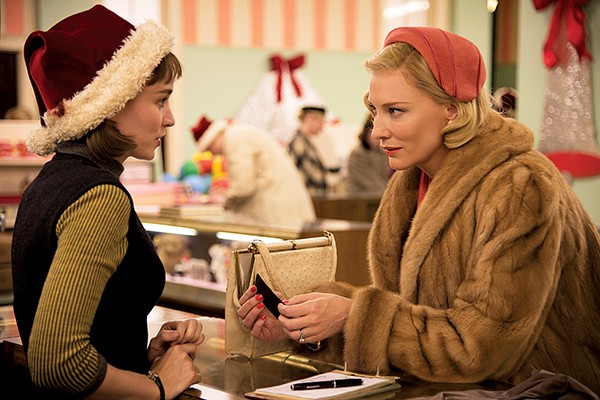Director Todd Haynes excels at portraiture. From Julianne Moore’s terrified housewife in Safe, to his sextet of competing portrayals of Bob Dylan in I’m Not There, Haynes has proven himself among the best at drawing character through social context and subtle gesture. Early in Carol, Haynes gives us a little primer on his methods. New York shop girl Therese Belivet (Rooney Mara) is hanging out in a movie theater projection booth with her beatnik friends. She asks aspiring writer Dannie (John Magaro) why he is taking notes about the movie they’re watching. He replies that he’s writing down the difference between what what people say and what they really mean.

Carol opposite Mara.
In a way, the repressed 1950s is the perfect era for Haynes’ sensibilities. He’s had great success with the setting in 2002’s Far from Heaven, but stumbled when he tried to operate in the decadent 1970s in his glam rock fantasia Velvet Goldmine. Like Far from Heaven, Carol owes a lot to Douglas Sirk, the director of 50s melodramas like Imitation of Life whose obsessively stylized images and heightened emotional landscapes earned him a sizable cult in the post-Stonewall era. But Carol, with its intense focus and and ability to address subjects that Sirk could have never gotten away with, transcends its influences.
Haynes trades Moore, with whom he collaborated on Safe and Far from Heaven, for Cate Blanchett, who gave the best Dylan in I’m Not There. Blanchett is among the best actresses working today, and Carol, the upper-class New Jersey housewife she inhabits under Haynes’ tutelage, is among her greatest creations. Carol is the kind of North Atlantic blue blood who pronounces tomato “tom-mah-tow,” but by the time we meet her, she has already transgressed polite society by having an affair with her friend Abby (Sarah Paulson). Her marriage to the gray flannel-suited Harge Aird (Kyle Chandler) is kaput, but there’s the matter of custody of their 4-year-old daughter Rindy (played by twins Sadie and Kk Heim) that must be resolved before their divorce is finalized. That’s when she happens to meet Therese, who is working in Haynes’ exquisite recreation of a grand 1952 department store decorated for the Christmas season.
Carol is at her most vulnerable, looking for a romantic connection she can’t find in her sham marraige. Therese, on the other hand, is agape at life, just trying to make it through her stressful retail day so she can go out and party with her meathead, would-be financé Richard (Jake Lacy) and their friends. “I barely even know what to order for lunch,” she says. Carol’s assurance and status bowls Therese over in a direction she’s never felt before. Soon, they drop everything and, like a lesbian Jack Kerouac and Neal Cassady, hit the road.

Cate Blanchett
But there’s another Eisenhower-era novel that features a pair of protagonists going on the road: Lolita. Even given the social strictures of 1953, there’s no getting around the fact that Carol is much older and more experienced than Therese, and there are layers of class and social privilege in play in the aristocrat’s courtship of the shop girl. It’s obvious, by the third act, that both women are struggling against internal forces they don’t fully understand.
Ultimately, the prevailing force is identified as love. But Haynes’ vision of love is not the conquers-all variety, but rather “we’ll muddle through, no matter the cost.” It’s a beautiful sentiment, befitting a beautifully constructed film from one of our era’s greatest filmmakers.